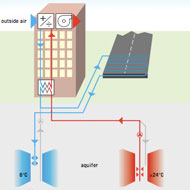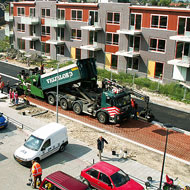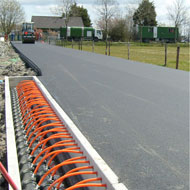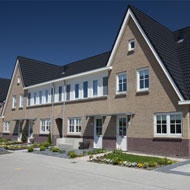Background
Road Energy Systems ® is a solar-heat-storing asphalt developed by Ooms Avenhorn Holding BV,a Dutch company. The stored solar energy can be used for many purposes, such as heating and cooling buildings and homes. Water is run through pipes under the asphalt and heated from the warmth of the road. This heated water is then pumped underground and stays warm at 68 degrees F. The water can be sent to nearby houses, and this water can be pulled up to prevent ice from building up on the road during winter months. Moreover, carbon dioxide emissions from using fossil fuels are reduced.
A test demonstrated the great potential of this technology. One test patch—200 yards of road and a small parking lot— generated enough heat for 70 apartments in a four-story building. This occurred under the typical cloudy Dutch weather with only a few days a year of sweltering temperatures (Blanco 2008).
In Waarland, Netherlands, the Road Energy Systems ® (RES) was combined with a d'Waert housing project in 2009. Thirty-five houses use the heating and cooling system generated by the RES collector. This collector also serves as an energy supplier for the entire neighborhood (De Peyler).
Lesson Learned
Potential Benefits:
- Provides economic and environmental benefits in the neighborhood.
- Generates clean electricity, eliminating the need for fossil fuels and preventing global climate change.
- Eliminates energy losses and transmission costs.
- Increases the durability of roads since the temperature-regulated pavements prevent rutting damage (Patterson 2011).
Potential Issues:
- Upfront cost: The pipes and solar road system double the cost of building the road, but payoff can be expected within 5-6 years (TNO 2011).
- Surface maintenance: There is concern about the system’s ability to support the weight and wear and tear of asphalt.
- Bumper-to-bumper traffic: Energy collection effectiveness is unknown in bumper-to-bumper traffic conditions.
- Financial and political barriers: The lack of revenue sources result in reluctance of federal and state government support (Patterson 2011).
Sources
De Peyler. “Bike Path as an Energy Supplier” (http://www.depeyler.nl/nl/5/335/road_energy_systems.aspx)
Ooms Avenhorn Groep (http://www.ooms.nl/)
Blanco, Sebastian, 2008. “In Future, the Road Heats You - Solar Energy Stored in Asphalt” (http://green.autoblog.com/2008/01/05/in-future-the-road-heats-you-solar-energy-stored-in-asphalt)
Patterson, Thom, 2011. “Solar-powered 'Smart' Roads Could Zap Snow, Ice” CNNTech. (http://www.cnn.com/2011/TECH/innovation/01/19/smart.roads/index.html)
TNO, 2011. SolaRoad Presentation. (http://www.tno.nl/downloads/Presentation%20SolaRoad%20definitief_uk.pdf)
Photo Sources
MIG, Inc.




